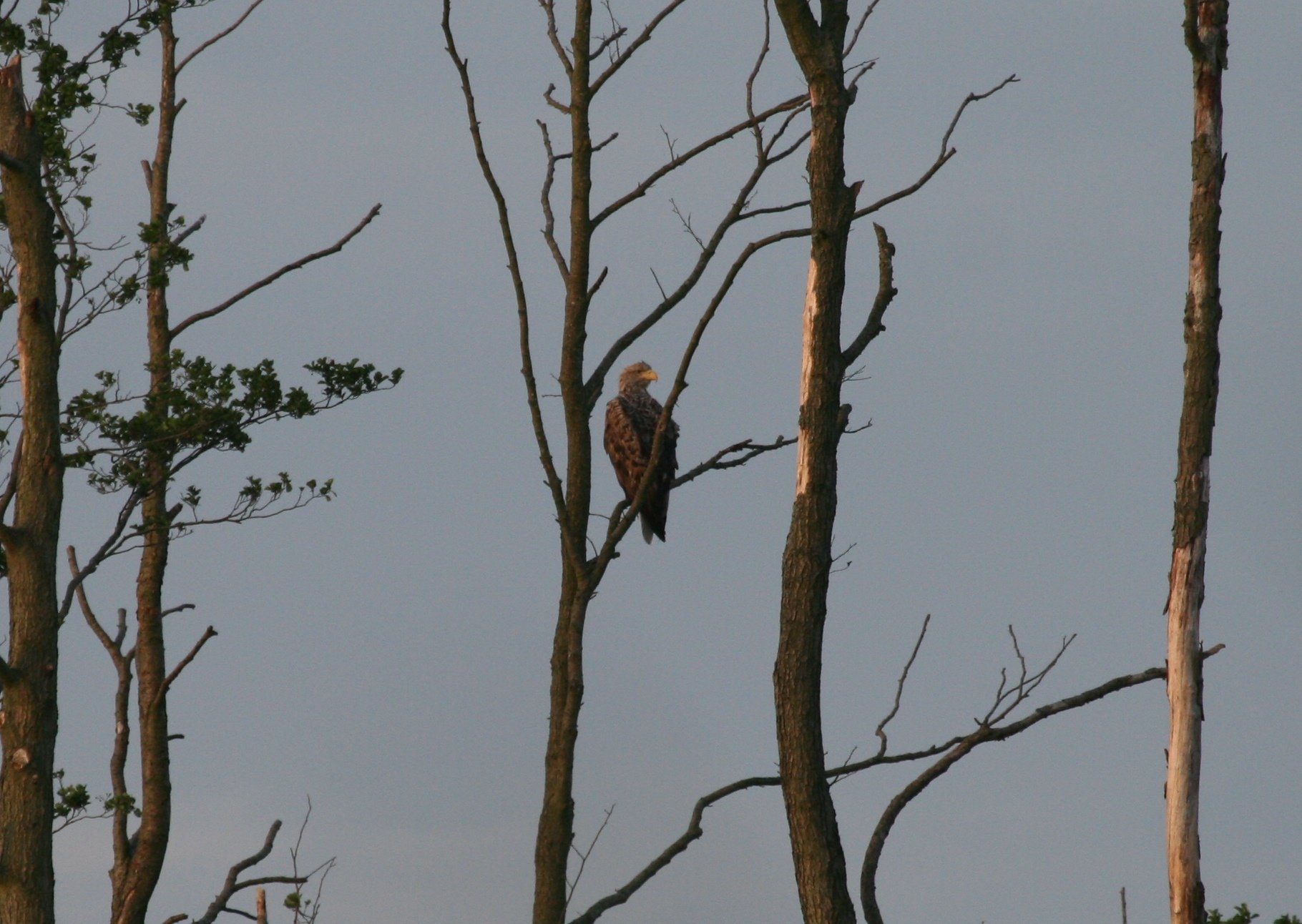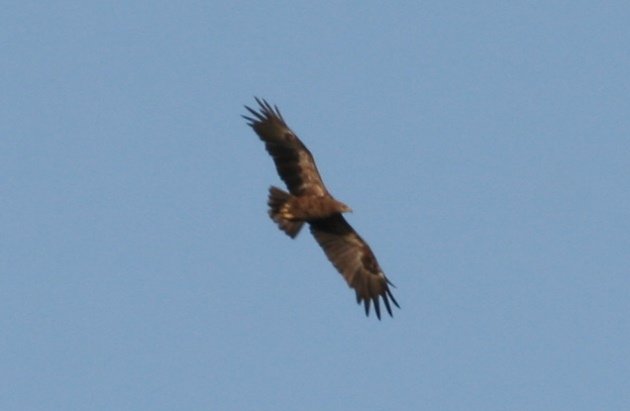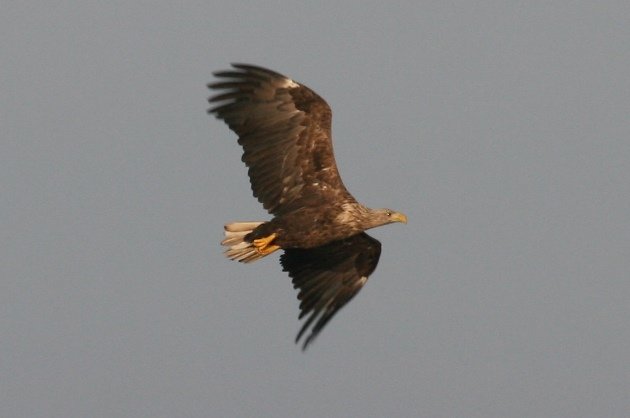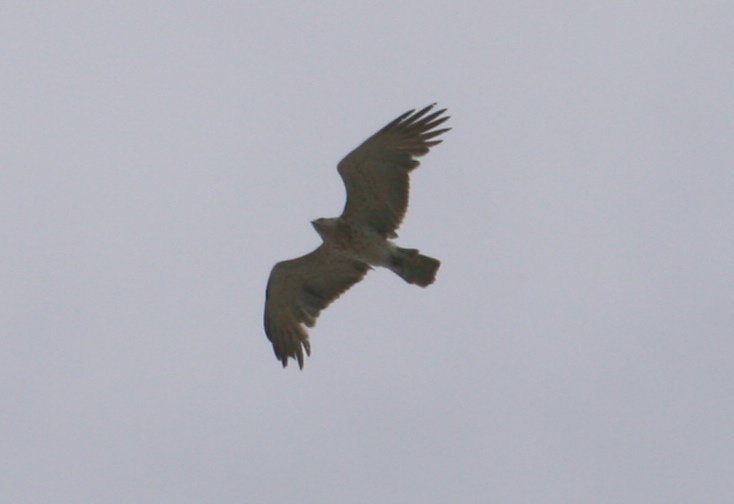
Whether the inspiration to this post came from Germany winning the U19 European football championship yesterday right on the heels of our (adult) team winning the world cup (Yes! Four stars!!), or from Coreys small series on national birds is left for you to decide. Regardless of what may have been my motivation, all eagles are exceptionally amazing birds that will scarcely ever fail to impress lucky birders. And since I consider Germany to be totally underrated as a birding destination, showing off some of our cooler birds is always in order – no matter how our national teams perform in any sport.
So here they are, the German eagles…
Osprey
Many may find the inclusion of the Osprey into a post on German eagles odd, but the German name of the Osprey translates to “Fish Eagle”, and German birders would find it self-evident to include the species here. Ospreys have shown a remarkable recovery in Germany. At the beginning of the 20th century they were nearly extinct, with no breeding pairs left in the west of Germany and just very few in Germany’s East. After a slow recovery, they were hit again by DDT in the 1970s, and there were only around 70 pairs left in Germany in 1975. After DDT was banned, things began to look much brighter, and the current population estimate of the Osprey in Germany is 700 to 721 pairs! They still mostly breed in the country’s North-East and only expand their geographic range slowly as young birds have a tendency of breeding in the immediate vicinity of their place of birth. There are now a few isolated pairs in Germany’s North-West again, in Rheinland-Pfalz and also in Bavaria. Attempts at re-introducing the species to Baden-Württemberg (SW Germany) were made during the late 1980s/early 1990s, but were unsuccessful. During migration, they can be seen throughout the country, but they are rather scarce and birders are generally very happy about seeing one, even if they do so a few times each year.
White-tailed Eagle
The White-tailed Eagle is regarded as the national bird of Germany and its population recovery is one of our most amazing success stories. As a small kid in the 1980s who had just gotten into birding, and before the German re-unification, I remember looking at a photo of several Bundeswehr soldiers carrying assault rifles who were standing in front of a tree trunk surrounded by barbed wire. They were protecting the last three pairs that were left in West Germany from egg thieves! Things looked much better in East Germany, where the population of just a handful of pairs at the beginning of the 20th century had increased to over 100 by the late 1980s. Allegedly, the German reunification had a boosting effect on the morale of this German national symbol and the species decided to show its support by increasing incredibly fast ever since. Seriously, there was just a slow but steady increase before 1990, and then the population suddenly exploded: From around 140 pairs around the time of Germany’s reunification, we are now busy counting to around 628 – 643 during the annual surveys, after little more than 20 years. Go Eagles!! The majority of the population breeds east of the river Elbe, from Schleswig-Holstein in the north (85 pairs, up from the 3 mentioned above!) all the way to Saxony. There are now isolated pairs elsewhere, even in Bavaria, and we can expect the species to one day be rather widespread again. However, unlike the Osprey the White-tailed Eagle is a true rarity outside its breeding areas, and I’ve only ever seen it once here in Germany’s South-West, while it is not uncommon to see groups of up to 50 in winter on the Baltic Sea coast.
Short-toed Snake Eagle
Well, okay. The inclusion of the Short-toed Snake Eagle is not quite as straight-forward as with the previous two. Germany has always been at the edge of its European range, and it was never common or widespread. However, there were scattered breeding pairs throughout Germany until around 100 year ago, and the species completely disappeared – so far as I was able to find out – roughly around 1950, largely because it was shot out of the sky. Since around the year 2000 we are seeing long-staying individuals each year again, especially in the country’s South, and there are rumours of a breeding pair on a military training ground in central Bavaria. The following image of an immature bird was taken by me (on my birthday) in July 2008 not far from said possible breeding location, so who knows? It might very well already be a German eagle again…
Lesser Spotted Eagle
The Lesser Spotted Eagle is a bit of a problem child here in Germany. They used to breed throughout the country, but were wiped out mostly through hunting more than 100 years ago. There still is a remnant population of a little more than 100 pairs (110-117 in 2013, essentially restricted to Mecklenburg-Vorpommern) in the North-East of the country which is connected to the large and rather healthy Polish population. However, the German breeding pairs are not doing too well, and the overall population is in slow yet steady decline. Unlike the other eagles which are all increasing thanks to hunting bans and the disappearance of DDT from the ecosystem, Lesser Spotted Eagles are faced with a reduction in suitable habitats throughout their very limited German range, as they require old-growth wet forests finely interwoven with moist meadows and wetlands. A migrant who spends the winter in the Afrotropical region, it leaves the German breeding grounds mostly in a south-eastern direction, making it a veritable rarity away from its German breeding range.

Golden Eagle
Golden Eagles have also recovered remarkably, although the species still has a long, long way to go if it is to reach its original population size and geographic range in Germany again – which, frankly, it probably never will. A few centuries ago, Golden Eagles bred throughout the country, from the Alps through the lowlands all the way to the coast. Well, hunting sure took care of that, and by the late 19th century the species was limited to remote regions of the German Alps, where no more than a handful of pairs survived. Since the 1920s, the species was protected from hunting and a slow yet steady recovery set in. The German Alpine population reached around 50 pairs again by the turn of the millenium, and has been stable at this level ever since. It is therefore suggested that the population in the German Alps has reached carrying capacity, which is a good thing. So far Golden Eagles have not been able to spread to the lowlands or surrounding mountain ranges. There are frequent observations of immature birds in the Black Forest, but so far no breeding pairs have been able to get established there. Honestly, no matte how well the Alpine population does, I do not expect that we will ever see Golden Eagles breeding in some remote lowland forest in northern Germany again. This makes the Golden Eagle a difficult species for Germany’s birders: while we do get wintering birds from Scandinavia on very rare occasions along the German coastline (North and Baltic Seas), the only realistic chances of seeing one in the country are by visiting the Alps. I guess it helps that they share their home range with Wallcreepers, Rock Ptarmigans and Snowfinches.
.
Booted Eagle
As with the Short-toed Eagle, the inclusion of the Booted Eagle in the list of German eagles is a bit of a shaky matter. This mostly Mediterranean to central Asian species is essentially a very rare vagrant to the country, with no more than a handful of records each year (of which maybe one or two are usually accepted by the records committees). However, the German birding scene was very surprised to learn about a successful breeding pair in a central German forest in 1995! It hasn’t bred there since (or anywhere else in Germany for that matter), and we are confined again to searching for migrant over-shoots. But who knows what 2015 might bring?

















Interesting info about the osprey. Way back when the United Stated was just beginning the osprey used to be called the ‘fishing hawk’. And while Germany has some great looking eagles, I still say the bald eagle is the best! It actually sounds like bald eagles had about the same situation over here in the US for a while as the osprey had in Germany.
Yes, it seems the positive trend in most German eagles due to hunting bans and reduced pesticides is mirrored in North America! Hurrah!
I agree that the Bald Eagle is more beautiful. However, it has rather narrow wings, especially the primaries, and is therefore less impressive than the White-tailed Eagle which is a real “brute” of a bird. Each species has its advantages…
This past June while searching for Wallcreeper on a trail between the villages of Graswang & Linderhof in Bavaria, I chanced upon a Golden Eagle feeding a juvenile in a nest high up on a rock facel. I have only observed Golden Eagle once before in Alaska. BTW, I’m still searching for Wallcreeper. – tlm, Colmberg, Germany
Awesome eagle encounter! did you ever catch up with a White-tailed Eagle at Altmühlsee?
Wallcreepers are moving away from their immediate breeding locations already (so far as I can see on onritho). Schloss Neuschwanstein is a generally good location for them, and for Crag Martins too if you hurry up (they’ll be leaving for the winter any time now).
I am in the UK
Just back from Gambia and of the rung Ospreys that we saw, the majority had black Darvics with white letters/numbers which I believe are German birds
Hi Pip!
According to cr-birding.com, black rings with white letters are either German, Latvian or from the UK. Most rings I can recall from Germany were white with black letters. Were you able to read any numbers? Gambia… I hope you had a great trip there, I’d really like to visit W Africa one fine day.
Hi Jochen,
I am not a birder but I found your essay while trying to identify an eagle that I saw recently near Rieps – MV. From your pictures and description it looks to have been a White-Tailed Eagle; not so unusual it seems but still a pretty cool encounter for me. The bird surprised me by taking off and wheeling away from a field next to the track where I was walking and when I looked behind the hedge there was a half-eaten Roe deer. Do you think the Eagle could have killed the deer itself or was it more likely scavenging? The only other predator I know of here is the wolf, but there are not many and there was evidence that the bird had already been feeding there for some time.
Anyway, it made an exciting change from the Rhea that I normally see. Thanks!
Hi Ed! Sorry for the late reply, I was off-line due to a short birding trip until now.
White-tailed Eagles are big birds but have rather weak talons, eating mostly fish and birds up to the size of a goose. Therefore, it is nearly impossible that the White-tailed Eagle had killed the Roe Deer itself, and was therefore almost definitely scavenging – which the species does on a regular basis.
A wolf kill would be quite exceptional indeed, even though Germany now has a population of apparently close to (or more than) 200! Another possibility is that the deer was injured in a car accident and died later away from the road.
Even though I’ve probably seen more than 1000 White-tailed Eagles during the last 20 years, I can tell you each and every one still makes a huge impression on me, they are amazing birds.
I hope you enjoy your Rheas! Have you seen this blog post of mine:
http://10000birds.com/greater-rheas-germanys-new-big-bird.htm
Cheers,
Jochen